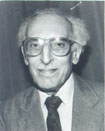
My dear Friends,
It is a festival time in most parts of our country. The festival of lights (Deepawali) is around the corner. I send my best wishes to you and your family on this occasion and also pray to Almighty to bless you all with happiness and success in your career and life.
In continuation with the series on- Legends in Neuropathology, I have great pleasure in sending a write-up on Prof.Darab K Dastur.I would urge the younger members of the society to kindly spare some of your time and read these ‘write-ups’. Any suggestions or criticisms are most welcome.
Dr. Dastur was born in Mumbai in the year 1924.He has his schooling at New Era public school which is located very close to Chowpatty beach.. After obtaining a B.Sc. in zoology and botany from the Wilson College, he received the medical education at the city’s famous Grant Medical College and Jamshetjee Jejeebhoy Hospital, graduating MBBS in 1949. He commenced his neuropathological work and research under his mentor, Dr. VR Khanolkar, at the Tata Memorial Hospital, Mumbai even while studying for his M.D. in medicine, which he obtained in 1952. It was Dr. Khanolkar who infused interest in leprosy, assigning to him the project “Cutaneous Nerves in Leprosy: Correlation of cutaneous sensibility with histopathological changes in nerves in Skin Biopsies”. The biopsies were obtained from patients at the Acworth Leprosy Hospital. This work, using the technique of intra-vital staining of dermal nerves recommended by Dr. AGM Weddell, earned Dr. Dastur a M. Sc. degree by research in 1953. The studies were also published in the prestigious journal Brain. At the Tata Memorial Hospital Laboratories, Dr. Dastur’s senior colleague was Dr. CGS Iyer another neuropathologist who devoted his life to the study of leprosy.
After a stint at the National Institute of Mental Health, Bethesda in the U.S. under a Rockefeller Fellowship studying brain circulation and metabolism, Dr. Dastur returned to Mumbai. In 1964 he founded and developed the Neuropathology Unit at the Grant Medical College and jamsetjee Jejeebhoy Hospital, holding the post of professor of Neuropathology till his retirement in 1981. His principal collaborator in leprosy research here, on a US Government funded project on “Nerve Lesions in Leprosy”, was Dr. NH Antia, the plastic surgeon. Experts from other disciplines in these and other institutes too sought his expertise and help. Drs. Noshir H Wadia, BS Singhal, EP Bharucha and Anil D Desai (Neurology); Drs. Gajendra Singh, RG Ginde, SN Bhagwati and Homi M Dastur (Neurosurgery); Drs. PM Udani and PE Bharucha (Paediatrics); Dr. Vasant Talwalkar (Paediatric surgery) have served as co-authors on several papers.
Prominent amongst his publications are the several papers in international and national journals and texts on neurological disorders on subjects as diverse as craniovertebral anomalies, spinal dysraphism, nutritional disorders, Wilson’s disease, tuberculosis, toxicology, degenerative disorders, slow virus infections and brain tumours, on which he has just written a book, which is in print. His publications resulting from such multi-disciplinary studies are frequently cited internationally.
The proforma which was to accompany any biopsy from a referring unit was famously detailed and many a neurology and neurosurgery resident learnt the hard but useful lesion that this pathologist was very PARTICULAR about full clinical documentation! One of the memorable characteristics of Dr. Dastur was his belief that it was the pathologist’s duty to examine the patient as well as the tissues. Every patient whose biopsy he was expected to report on, was, whenever possible, personality examined. It took some time for the clinicians to get used to the presence of this lanky figure in their wards, taking a detailed history, carrying out a meticulous examination of the patient and then comparing his own notes with those provided to him by the resident doctor. He was never too busy to teach but laid down exacting requirements. He communicated his enthusiasm and sense of wonder to generations of post-graduate students from the clinical disciplines and from the basic sciences as he demonstrated details on the gross specimen and through the microscope at length. The “brain-cutting sessions” conducted once weeks with some ceremony are fondly remembered by all those who were privileged to participate.
He received numerous awards for his professional accomplishments and the Rameshwardas Birla National Award for Outstanding Research (1991). He was VR Khanolkar Orator in 1989 and Dorothy Russell orator at Queen square, London. Professor HM Zimmermann named him one of the “39th Neuropathologists of the 20th Century”. It is truly outstanding feat and a matter of pride for all of us.
Dr. Dastur’s credo of life was summed up by in one word – “Work”. A liberal in his personal philosophy, Dr. Dastur, a Zorastrian by birth, gained much inspiration from the Bhagwad Gita, and according to his wishes was cremated with Hindu rituals. Grieving their loss are his devoted wife Hilla, their two children, two grandsons, not to speak of numerous students, staff and professional associates.